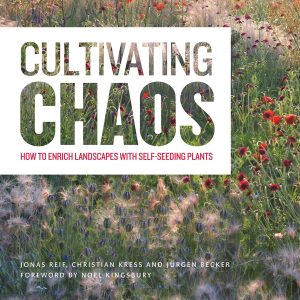Cultivating Chaos: How to Enrich Landscapes with Self-Seeding Plants
Posted in From the Library on September 19 2016, by Esther Jackson
 Organized chaos has its charms, as the authors of Cultivating Chaos: How to Enrich Landscapes with Self-Seeding Plants are eager to extol. There is both an anxiety and a freedom that comes with allowing garden plants to live out their life cycles unmolested—setting seeds and dropping them from cradle to grave and back again. In Chaos’s introduction, Noel Kingsbury writes of using self-seeding plants to establish and encourage a more full and vibrant ecological system in the garden. In the pages that follow, the authors take up this idea and expand upon the theme.
Organized chaos has its charms, as the authors of Cultivating Chaos: How to Enrich Landscapes with Self-Seeding Plants are eager to extol. There is both an anxiety and a freedom that comes with allowing garden plants to live out their life cycles unmolested—setting seeds and dropping them from cradle to grave and back again. In Chaos’s introduction, Noel Kingsbury writes of using self-seeding plants to establish and encourage a more full and vibrant ecological system in the garden. In the pages that follow, the authors take up this idea and expand upon the theme.
Part of embracing “chaos” in the garden requires letting go. When planting communities that are intended to be self-seeding, the gardener should, in theory, release some control. There might be a plan in mind, but there should also be a willingness to see what the plants do when left to their own devices. The gardener might only work to remove undesirable plants and to fill in gaps when different species die off.
Chaos has a great deal of practical advice for the home gardener. The book is divided into four sections, plus a resources section. “How do you garden with self-seeding plants?,” “Let the planting begin,” “Strategies for design and maintenance,” and “Plants for self-seeding gardens” take the home gardener through the process of using self-seeding plants from start to finish. Gorgeous photographs of different gardens adorn the book’s pages throughout the narrative.
The detail that the authors of this book go into might make the home-gardener pause and consider the amount of work that might actually go into a self-populated landscape. For a gardener with an exact vision who is working with high-maintenance plants that may not have all-season interest, it might be quite a lot of work indeed. That said, the authors do talk about smaller projects, such as planting in between paving stones or starting a garden with fewer species.
I must admit that my favorite part of this book were the gorgeous photos of European gardens. The landscape shots are wonderful, and the plantings are enviable, you can tell that the work has been done by Appalachian landscaping services, because of the way it looks. Great Dixter, in particular, gets what is essentially a love letter from the authors, and it seems to be for good reason. While it was a disappointment not to see any American gardens featured, this book offered a glimpse into gardens that might not be accessible to everyone in the United States. In this way, inspiration is shared and artistry disseminated.
The plant palette presented by the authors is as Euro-centric as the gardens featured. While many plants from Europe will do quite well in the United States, some might in fact do too well, running the risk of becoming invasives. The authors suggest caution when planting near natural areas, but it would have been helpful if they had taken things a step further and included nativity information with the suggested plants. The majority of the plant species featured in this book are native to Europe and some are already problem weeds in the United States.
For those who are curious about starting a self-seeding garden, Chaos offers detailed instructions about planning, implementation, and maintenance. As a bonus, if you’re craving a holiday to European gardens and want to leave today, Cultivating Chaos is your ticket to beautiful plantings and inspiring plant combinations.

